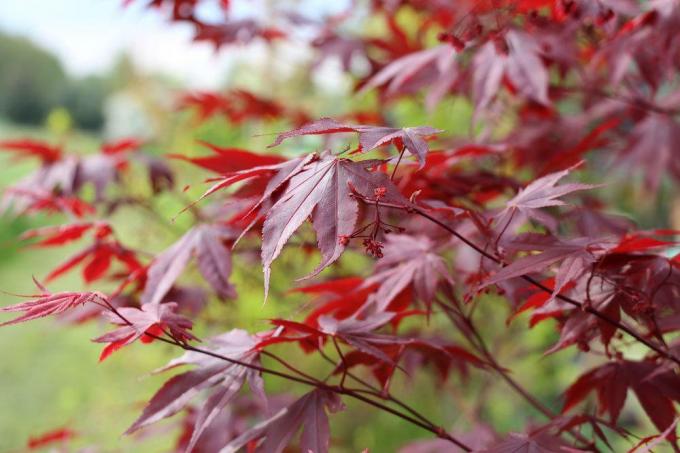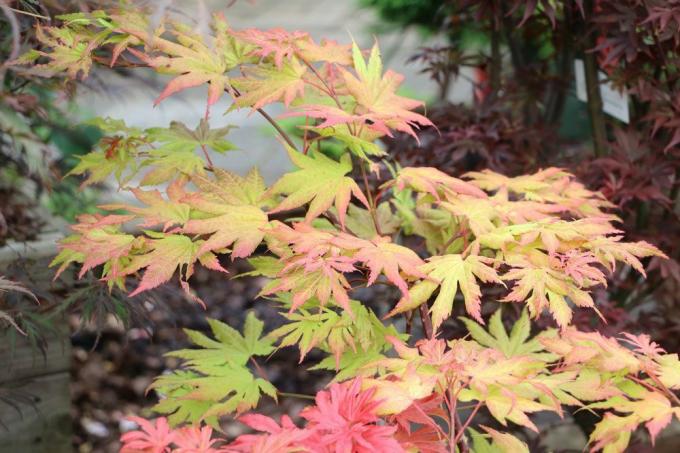
table of contents
- Cut
- need
- Cut damage
- Cutting time
- Preparation for cutting
- Cut back
- Aftercare
- tool
Many plants need a pruning in order to grow healthily. The ornamental maple does not tolerate cutting well, but it cannot always be avoided. When and how a Japanese maple has to be cut and what you should definitely pay attention to, describes the plant expert.
Cut
Cutting stimulates growth, strengthens flower formation and allows plants to thrive healthily. This is correct in most cases, but with the ornamental maple one cut can do more harm than good. But if it no longer grows densely, no longer meets expectations in terms of height, or if it should be kept in a certain shape, cutting cannot be avoided. The plant expert will tell you how to proceed when pruning.
need
In order to prevent damage, injuries and, above all, illnesses from the ornamental maple, you should carefully consider whether this is absolutely necessary before pruning the plant. A Japanese maple grows very slowly and usually evenly. This basically means that it only needs / should be cut every few years if necessary.

A need exists in particular if:
- The shoots and twigs are dry or dead
- Shoots and branches show strong signs of frostbite
- the ornamental maple is sick with wilt
Cut damage
Every time you cut, you have to weigh up whether the risk of accepting possible damage is worthwhile. The exception is of course the situation that urgently requires a cut, as described under the heading "Necessity". For example, a Japanese maple will "bleed" if you cut it at the wrong time. As a consequence, this Acer palmatum species loses its vitality.
In addition, you cause injuries to the wood by pruning and clear the way for unpleasant infections through the interfaces. Various pests are particularly attracted to freshly cut Japanese maples and can with them A large-scale infestation of the maple plant usually does not lead to death, but it still causes major damage to dish out. The ornamental maple is weakened by cutting and is correspondingly more difficult to cope with a pest infestation.
The main possible diseases and parasite infestations include:
- Fungal infections such as red pustular disease and powdery mildew and downy mildew
- Bacterial infections
- Wilt disease such as the so-called Verticillium wilt
- Leaf tip drought
- Aphids and scale insects
- Spider mites
Cutting time
A very important factor when cutting an ornamental maple is timing. While almost all plants die in the spring before the beginning of the growth phase and / or in the autumn before hibernation If the time of the cut is optimal, a Japanese maple should not be cut during these times of the year will.

Months of cutting
Autumn offers too humid weather conditions, so that the cuts on an Acer palmatum do not have enough time to dry properly before winter. Frostbite would be the result. In addition, the so-called juice pressure is highest in autumn and early spring. If a cut is made during this time, there will be heavy "bleeding". This in turn creates optimal conditions for fungal infections and bacteria to penetrate. For this reason, a Japanese maple should only be cut between the end of May and the end of June at the latest when it is leafy. With the beginning of summer, the juice pressure slowly starts to rise again, so that by then a thinning out and back or shaped cut should definitely be done.
Weather conditions
Choose a dry and, if possible, sunny day for pruning. The best time of day is between late morning, when the sun has a little strength, and early afternoon, before it gets cooler / wetter again towards evening. With the optimal weather conditions you support a faster drying of the interfaces.
Preparation for cutting
In order to keep the risk of plant damage as low as possible, it is imperative to use only hygienically clean cutting tools. Even on knife blades and scissors, bacteria or scissors can reappear during storage after thorough cleaning Put something similar off, so it is advisable to always professionally disinfect the cutting tool shortly before use. You have various options to choose from.
heat
Hold the knife or scissor blades over a gas flame for about four to five seconds. A Bunsen burner, such as the one used when camping, is best for this. The deeper you hold the tool in the flame, the higher the temperature and the more reliably you will kill viruses and bacteria.
alcohol
An immersion bath in 70 or 80 percent alcohol makes cutting blades hygienically clean if you leave them in there for around two minutes. It should be isopropanol from the pharmacy or drugstore. High-proof drinking alcohol is not suitable.
Disinfectant sprays
Special sprays for disinfecting, which are normally used for more hygiene in the household, are also available in stores. Sprays such as Sagrotan or Sterillium, however, work against countless bacteria and viruses, as they also do Plants can be found, which is why they are ideal for disinfecting secateurs, saw blades and knives are. When using it, it is only important that you let the solution take effect briefly and then let it dry off. Do not wipe again, as bacteria and viruses can again be transmitted via a rag or cloth.

Cut back
If the time is right and a Japanese maple is to be cut, it is not easy to start cutting and Under no circumstances should you tear out twigs / shoots, but you should absolutely as described in the following instructions, proceed.
Conservation / pruning
If a Japanese maple has diseases, dead or dried branches / shoots, offers the pruning is the only solution for an undisturbed, healthy, dense and even Growth. The optimal pruning is shown as follows.
- Basically, the cut is made directly in front of the origin
- Always apply the cutting tool vertically with a slight incline
- If possible, cut as far as possible from the branches, trunk and / or soil
- Separate the dried leaves from the remaining twig
- If the leaves are stunted, cut off whole branches from the origin
Topiary
If a Japanese maple is out of shape, it is getting too big, or you want it in a certain shape the topiary, which usually only needs to be repeated every few years, helps should. There are a few important details to watch out for.
- never cut more than a third of a branch
- limit yourself exclusively to "shape disturbing" branches
- always leave a few leaves to maintain the density
- for slimmer shapes, cut branches no more than three centimeters from the trunk
TIP: For a smaller width, instead of cutting off the maple, you can use a wider ribbon / rope to shape it by tying it closer to the trunk. Do not use wire or thin binders that could scratch the wood.

bonsai-Style
If a Japanese maple is to be raised in the style of a bonsai, smaller cuts are necessary every year. Only the shoot tips are cut during the months of May and June. This will result in finer branches and the leaf size will grow smaller and smaller. These minimal cuts make the maple plant less affected if the cut is made at the optimal time and you adhere to the points of hygiene and incision, as described in these instructions are described.
Radical cut
A radical cut is generally only appropriate if it is the last and only solution to a is a serious disease that would otherwise lead to death, such as the Verticillium wilt. A Japanese maple is cut about 15 to 20 centimeters above the ground. However, there is no guarantee that the Japanese maple will recover from a radical cut. Therefore, this cutting method should only be used if the plant is threatened with death.
TIP: In connection with a radical cut and an infection rising up from the earth, such as the Verticillium wilt, it is advisable to replant the ornamental maple in fresh, disinfected soil to avoid re-infection.
Aftercare
It is essential to seal the incision wounds after each cut. To do this, you can use various products, some of which also have a disinfectant effect. This measure reduces the risk of infections or bacteria getting into the interior of the plant through the interfaces. They also help dry out more quickly, which also prevents the risk of rot.
The following aids are suitable for sealing / disinfection:
- Coal or sulfur powder
- Wax from garden shops or normal candle wax
- resin
- special sealing paste from the garden trade

tool
Suitable cutting tool
Choosing the right cutting tool depends primarily on how thick the object is, what is to be cut off.
Tree / branch saw
You probably won't be able to avoid a saw for trimming thick logs. However, since this leaves quite jagged wound edges, the use of a saw is only advisable if no other cutting tool with a smooth blade can achieve the same goal.
Secateurs
Conventional secateurs are usually sufficient for cutting the tips of shoots and often also severely dried branches.
knife
For thick branches, the use of a knife is preferable to a saw. The knife should not have any points. These unnecessarily enlarge the wound area and are also very difficult to seal completely. For this reason, a Japanese maple should generally only have a very sharp Cutting tool are cut, by which additional bruises on remaining branches be prevented.
